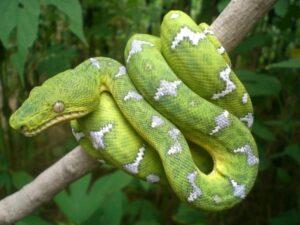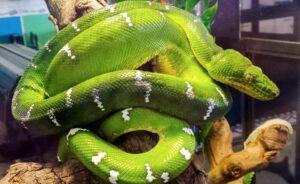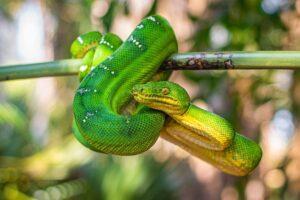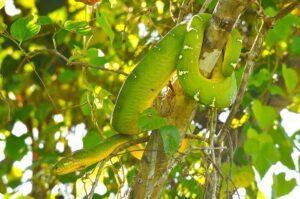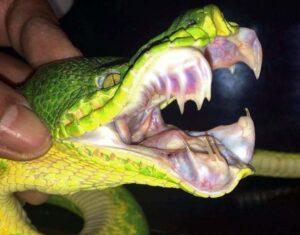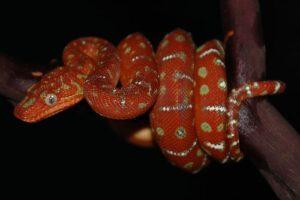The tree-dwelling emerald tree boa is perfectly adapted to its South American habitat. Its bright green color and compact coils help it camouflage among the foliage of the rainforest. The specific name ‘caninus’ is in recognition of its elongated maxillary teeth that look like that of dogs. The boa’s angled snout and head are also reminiscent of dogs.
Scientific Classifications
- Suborder:Serpentes
- Family:Boidae
- Genus:Corallus
- Species:C. caninus
Conservation Status
Description
Size
A full-grown emerald tree boa gets as big as 6 ft (1.8 m) in length. It weighs around 3.3 lbs.
Color and Appearance
The base color of this boa is emerald green with white irregular broken zig-zag stripes like lightning bolts running down its back. Their teeth are highly developed and larger than any other non-venomous snake. They are used to penetrate the plumage of birds, one of their food sources. They have a yellow belly.
The head of the constrictor is heart-shaped. It has a narrow neck, stout body, and a long prehensile tail.
Are They Dangerous to Humans
Though the emerald tree boa is non-venomous, its bite can cause severe injury to both the victim and the snake. The person suffering the bite may need several stitches, risk infection, and even permanent damage to his nerves. On the other hand, the boa can snag its tooth from a bite, resulting in severe pain and infection in its mouth. Another common injury that can cost the snake its life is its spine separating from its cranium. It happens when the snake latches on hard, and the victim instinctively pulls away.
There have been no documented human deaths due to the emerald tree boa.
In captivity, it shouldn’t be handled frequently as it causes stress and can damage its prehensile tail. So it is best to enjoy it from afar. It can be handled only for short periods if properly approached. It can bite if it feels threatened or startled.
Emerald Tree Boas at a Glance
Distribution
The species is found in the northern part of Columbia, Brazil, Suriname, Venezuela, and Guiana, that fall within the Guiana Shield.
Though no estimate of its population is available, it is encountered more frequently in Venezuela and less in Brazilian Guiana and Suriname.
Habitat
It lives in lowland tropical rainforests with heavy precipitation.
This arboreal snake species spends most of its life in bushes and trees.
Though the species is nowhere near extinction, there are some concerns over its population. Foremost is habitat lot due to rapid urbanization, followed by pet trade and hunting by humans. The snake is culturally significant in South America and is killed for fashion, prizes, and local medicines.
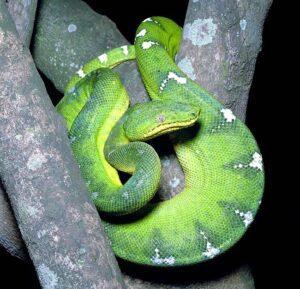
Lifespan
The emerald tree boa lives for about 15 years.
Predators
Its main enemies are birds of prey, such as the Guianan crested eagle.
Its strongest weapon against its predator is its excellent camouflaging ability. Plus, owing to its slow metabolism, it eats and excretes less often, leaving no trails of smell for its enemies to hunt it down. It waits for a rainy day to defecate so the water can wash away its feces.
Diet
It mainly eats small mammals like rodents and marsupials but is also known to take smaller birds, lizards, and frogs. An extremely slow metabolism makes it eat several months apart.
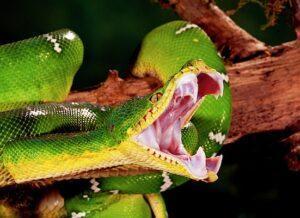
It tightly coils around its prey to kill it by way of constriction. It doesn’t use its teeth to kill its prey but only to stun it or pin it in place.
Reproduction
Ovoviviparous (gives birth to live young from eggs that hatch inside the body)
6-14 babies are born to a female at a time, sometimes even more. The juveniles can be brick red or various shades of dark and light orange. They gradually turn emerald green over 9-12 months.
Similar Species
Green Tree Python (Morelia viridis): It can have brick red or canary yellow juveniles. But the emerald tree boa can never have yellow babies. There are also differences in the head scaling and the head pit locations around the mouth.
Amazon Basin Emerald Tree Boa (Corallus batesii): It is bigger, reaching a length of 7-9 ft (2.1-2.7 cm). The white line on its back is uninterrupted and doesn’t resemble a lightning bolt. It is also more docile.
Care Sheet
This snake is a stunning candidate for display enclosures, although it is aggressive and usually doesn’t make a good pet. There are also protective laws in Brazil forbidding its capture from the wild. So one should always ask questions about the origin of the boa before making a purchase.
Size of the Enclosure: The ideal tank size for housing an adult is 3 ft (length) x 2.5ft (width) x 2.5 ft (height). It should have lots of sturdy branches and perches at different heights.

Temperature: The high ambient temperature in the daytime should be 84°F. It can fall to 78° Fat night. The temperature of the basking spot should be between 88°F and 93°F.
Humidity: The ideal humidity for the cage setup is 65%-75%. A non-porous water bowl should be placed in the terrarium.
Substrate: Newspaper, butcher paper, orchid bark, or cypress mulch make suitable substrates for the vivarium.
Feeding: The juveniles can be given 1 rodent of appropriate size (not exceeding the girth of the baby snake) weekly. The adults can be fed 1 rodent every 2 weeks.
Source
creatures-of-the-world.fandom.com, snakecountry.com, brevardzoo.org, nature-myview.com, monaconatureencyclopedia.com, i.pinimg.com, images.fineartamerica.com, ball-pythons.net

